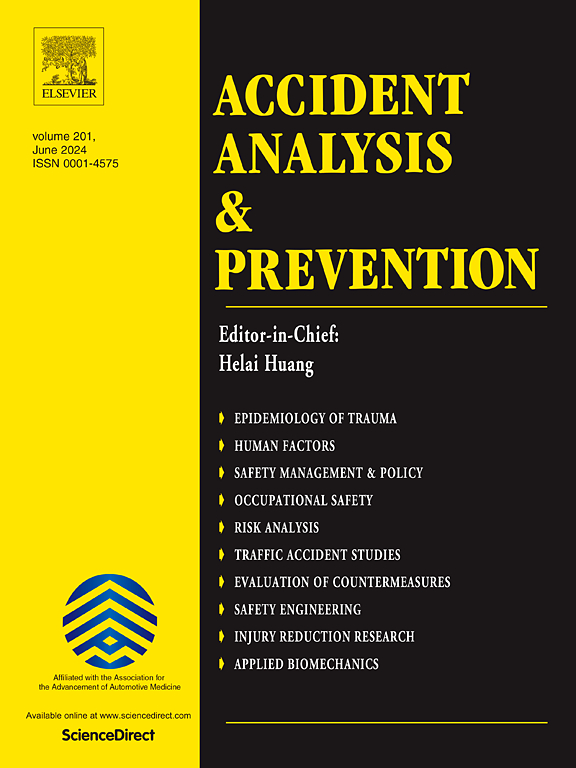The existence and impacts of sequential traffic conflicts: Investigation of traffic conflict in sequences encountered by left-turning vehicles at signalized intersections
IF 6.2
1区 工程技术
Q1 ERGONOMICS
引用次数: 0
Abstract
The traffic paths of vehicles, pedestrians and non-motorized traffic at signalized intersections are complicated, and the phenomenon of not strictly obeying the right of way is frequent, which leads to more conflict points at the intersection. Vehicles are prone to Sequential conflicts while passing through intersections, which depletes attention resources, reduces response capacity, and increases accident risk. Therefore, analyzing Sequential Traffic Conflicts at intersections is a key focus of traffic safety research. The purpose of this study is to prove the existence of complex scenarios of sequential traffic conflicts, demonstrate the impact of initial conflicts on subsequent conflicts, and discuss the impact of different class variables on the severity of sequential traffic conflicts. A multi-dimensional severity assessment system was developed, and two nonlinear binary logistic regression models were established: one considering the correlation between conflicts and one assuming independence. Significant variables influencing Sequential traffic conflicts were categorized and analyzed. A typical left-turn scenario was selected for analysis. The results show that the occurrence of the initial conflict significantly influences the subsequent conflict. The model considering correlation outperforms the independent conflict model, confirming the existence of interdependence between conflicts. The severity of the first and second conflicts is negatively correlated, with the second conflict being more severe. Factors such as participant speed, group size, arrival time at the conflict zone, non-motorized vehicle direction, and left-turning vehicles’ willingness to continue crossing significantly affect conflict severity. Based on this, effective strategies for enhancing the safety of sequential traffic conflict scenarios are proposed.
序贯交通冲突的存在及其影响:信号交叉口左转弯车辆序贯交通冲突的研究。
信号交叉口车辆、行人和非机动车辆的通行路径复杂,不严格服从路权的现象频发,导致交叉口的冲突点较多。车辆在通过交叉路口时容易发生顺序冲突,消耗了注意力资源,降低了响应能力,增加了事故风险。因此,交叉口序贯交通冲突分析是交通安全研究的一个重点。本研究旨在证明顺序交通冲突复杂场景的存在性,论证初始冲突对后续冲突的影响,并探讨不同类别变量对顺序交通冲突严重程度的影响。建立了多维严重程度评价体系,建立了考虑冲突相关性和独立性的非线性二元logistic回归模型。对影响顺序交通冲突的重要变量进行分类和分析。选择一个典型的左转场景进行分析。结果表明,初始冲突的发生对后续冲突有显著影响。考虑相关性的模型优于独立冲突模型,证实了冲突之间存在相互依赖关系。第一次冲突和第二次冲突的严重程度呈负相关,第二次冲突更严重。参与者速度、群体规模、到达冲突区域时间、非机动车辆方向、左转车辆继续穿越意愿等因素显著影响冲突严重程度。在此基础上,提出了提高序贯交通冲突场景安全性的有效策略。
本文章由计算机程序翻译,如有差异,请以英文原文为准。
求助全文
约1分钟内获得全文
求助全文
来源期刊

Accident; analysis and prevention
Multiple-
CiteScore
11.90
自引率
16.90%
发文量
264
审稿时长
48 days
期刊介绍:
Accident Analysis & Prevention provides wide coverage of the general areas relating to accidental injury and damage, including the pre-injury and immediate post-injury phases. Published papers deal with medical, legal, economic, educational, behavioral, theoretical or empirical aspects of transportation accidents, as well as with accidents at other sites. Selected topics within the scope of the Journal may include: studies of human, environmental and vehicular factors influencing the occurrence, type and severity of accidents and injury; the design, implementation and evaluation of countermeasures; biomechanics of impact and human tolerance limits to injury; modelling and statistical analysis of accident data; policy, planning and decision-making in safety.
 求助内容:
求助内容: 应助结果提醒方式:
应助结果提醒方式:


